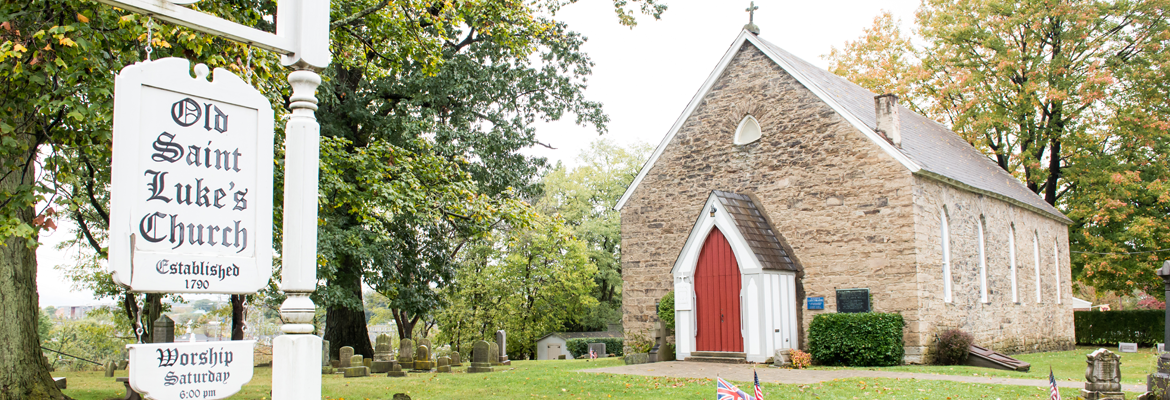Historic Old Saint Luke’s: 1765 to the Present
 Panthers roamed the woods filled with chestnut trees. Chief Catfish followed the path along Chartiers Creek which flows from Washington, PA and McKees Rocks, PA.
Panthers roamed the woods filled with chestnut trees. Chief Catfish followed the path along Chartiers Creek which flows from Washington, PA and McKees Rocks, PA.
This was the scene that greeted young Captain David Steel and the British Engineers, who were sent to secure a lookout to protect Fort Pitt from the Indians. From The Point in Pittsburgh, they paddled down the Ohio River to the outlet of Chartiers Creek at McKees Rocks.
On a promontory about six miles from Pittsburgh, above the Creek a stockade was built in 1765 at the site of the present Old Saint Luke’s Church in Scott Township. Today an old stone Country Gothic church stands as testimony to the pioneer faith and fortitude that led to the establishment of the Church of England in Western Pennsylvania, the western frontier of that time.
It has been said that geography is destiny. Water, abundance of wild life and fish attracted early settlers. For payment of his service in the French and Indian War, Major William Lea selected his King’s Grant land near the creek where the stockade had been built. A parcel of his land was willed for the use of the church. Hilly terrain and mountains isolated the eastern from the western regions of Pennsylvania. Pittsburgh with three navigable rivers could not ship via the Ohio to New Orleans because of French control until the Louisiana Purchase. The Allegheny Mountains were a formidable barrier to cross to the east. The poor, struggling farmers converted their rye into whiskey, their only cash crop, for transport to the east.
Alexander Hamilton saw whiskey as a source of much needed revenue for the fledgling government. The farmers argued otherwise, Whiskey Rebellion then resisted paying. This led to the Whiskey Rebellion, the first test of the Constitution. General John Neville, boyhood friend of George Washington was appointed tax collector.
Events reached a climax at General Neville’s Bower Hill Plantation with the shooting and death of Oliver Miller and Major James McFarlane, leader of the rioters. Using 13,000 troops in the area, President George Washington was able to quell the insurrection. However, the schism created in the church led to the first decline in Old Saint Luke’s. Dissension among Old Saint Luke’s members who sided with the Federalists or with the Anti-Federalists resulted in the exodus of the many affluent members. Resentment to Gen. Neville and the wealth that he represented continued. Even though Old Saint Luke’s no longer had ties with the Church of England after the Revolutionary War, the War of 1812 reinforced resentment to anything even remotely connected with England.
The very existence of Old Saint Lukes today is short of miraculous. After the church closed in 1930 it fell into disrepair. Volunteers lovingly restored the “church without a congregation.” A group of dedicated volunteers maintain Old Saint Luke’s by presenting local history to student and adult groups, weddings, Easter sunrise service, Thanksgiving, and a different ethnic Christmas service which draw large numbers to a church that is very much alive after being pronounced dead in 1930.
In Memoriam:
The Rev. Canon Richard W. Davies
President Emeritus and Historian, Old Saint Luke’s Church
1927 – 2020

The Rev. Canon Richard W. Davies passed away peacefully on May 7, 2020 surrounded by his family. Richard began serving as the Vicar of Old St. Luke’s in 1990. His contributions to preserving Old St. Luke’s and the region’s history have been immeasurable and he will be greatly missed. May he rest in peace and rise in glory.
Click here to read Richard’s full obituary. The Episcopal Diocese of Pittsburgh also published a notice which can be found by clicking here.
To view of video tour of Old St. Luke’s conducted by Rev. Davies, click here.
Bishop’s Chair Returns to Old Saint Luke’s Church
Please click the link below to read the full Post Gazette article:
Old Saint Luke’s Floor Restored to Original Beauty

Volunteers help remove pews. 
An empty church awaiting the sanding crew! 
Sanding in progress. 
More sanding… 
Ready for stain! 
Restored to its former glory! Ready for pews to come back. 
All finished! 
Thanks to all who helped make our project go quickly and smoothly.
What a Find!
The property behind Old Saint Luke’s Church is now a private residence, but it was once the site of a schoolhouse. During a September 14, 2019 visit to the property, treasure hunters Terry Filby and his 14 year old son Nathan Filby used metal detection equipment to unearth a 1787 New Jersey copper coin. Minted from 1786 to 1790, the coin was the first to bear the national motto, “E Pluribus Unum” (One from many). Terry and Nathan kindly donated the coin to Old Saint Luke’s Church.
















